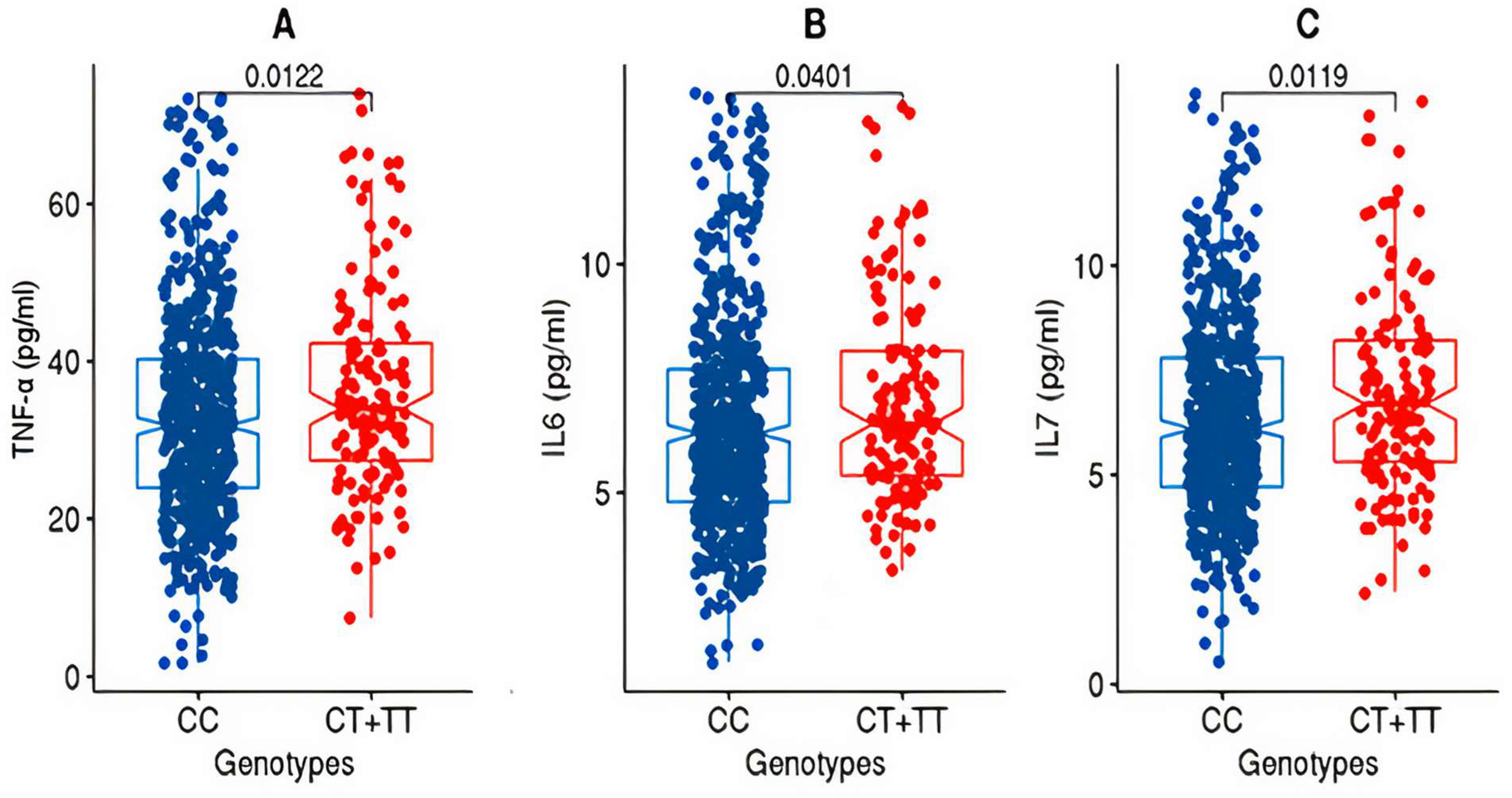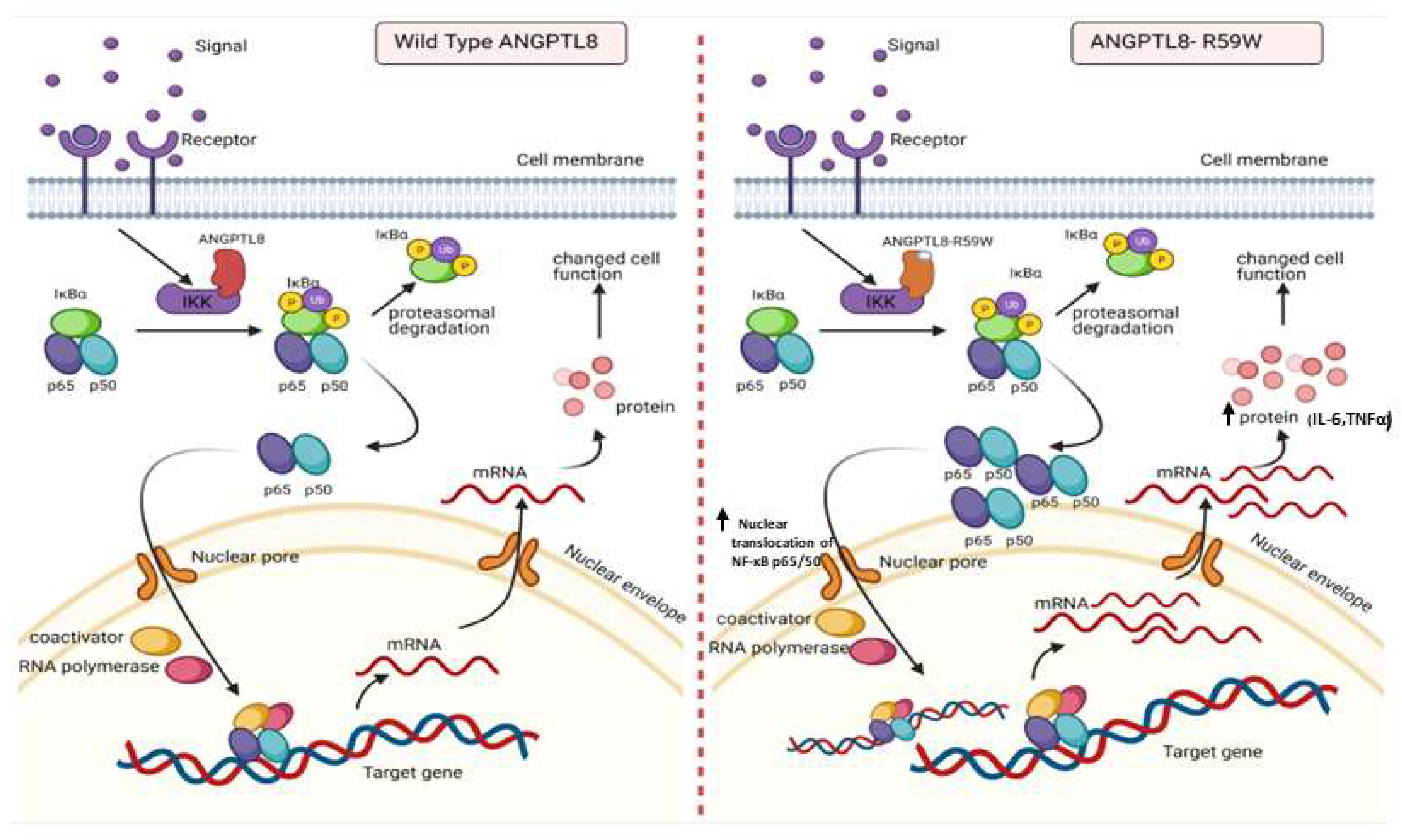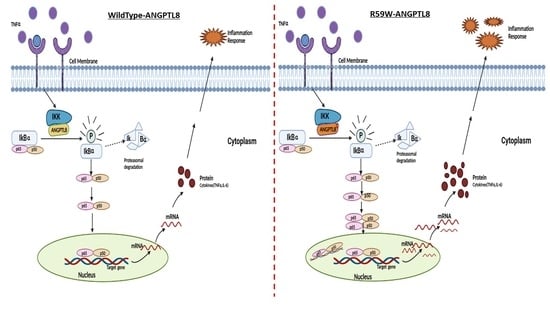The Proinflammatory Role of ANGPTL8 R59W Variant in Modulating Inflammation through NF-κB Signaling Pathway under TNFα Stimulation
Abstract
1. Introduction
2. Materials and Methods
2.1. Recruitment of Participants and Study Cohort
2.2. Blood Sample Collection and Processing
2.3. Estimation of Plasma Levels of Various Biomarkers
2.4. Targeted Genotyping of the ANGPTL8 Study Variant R59W
2.5. Quality Check Procedures for SNP and Trait Measurements
2.6. Allele-Based Association Tests and Thresholds for Ascertaining Statistical Significance
2.7. Cell culture, Transfection, and Treatment
2.8. Western Blot Analysis
2.9. Luciferase Activity
2.10. Structural Analysis of ANGPTL8 and Binding to IKKβ
2.11. Power Calculation
3. Results
3.1. Study Cohorts
3.2. Characteristics of the R59W Variant
3.3. Characteristics of the Study Cohorts
3.4. Association of the ANGPTL8 rs2278426 Variant with Increased Circulatory Levels of TNFα and IL7
3.5. R59W Variant Activates NF-κB Pathway Compared to the Wild Type
3.6. R59W Variant further Elevates Activation of the NF-κB Signaling Pathway Compared to the Wild Type under TNFα Stimulation
3.7. Impact of NF-κB Activation on Other Inflammatory Cytokines
3.8. Structural and Binding Analyses for the ANGPTL8 R59W Variant and the Wild Type
3.9. Results from Power Calculation
4. Discussion
Supplementary Materials
Author Contributions
Funding
Institutional Review Board Statement
Informed Consent Statement
Data Availability Statement
Acknowledgments
Conflicts of Interest
References
- Magliano, D.J.; Islam, R.M.; Barr, E.L.M.; Gregg, E.W.; Pavkov, M.E.; Harding, J.L.; Tabesh, M.; Koye, D.N.; Shaw, J.E. Trends in incidence of total or type 2 diabetes: Systematic review. BMJ 2019, 366, l5003. [Google Scholar] [CrossRef] [PubMed]
- Scicali, R.; Giral, P.; D’Erasmo, L.; Cluzel, P.; Redheuil, A.; Di Pino, A.; Rabuazzo, A.M.; Piro, S.; Arca, M.; Béliard, S.; et al. High TG to HDL ratio plays a significant role on atherosclerosis extension in prediabetes and newly diagnosed type 2 diabetes subjects. Diabetes Metab. Res. Rev. 2021, 37, e3367. [Google Scholar] [CrossRef] [PubMed]
- DeFronzo, R.A.; Ferrannini, E.; Groop, L.; Henry, R.R.; Herman, W.H.; Holst, J.J.; Hu, F.B.; Kahn, C.R.; Raz, I.; Shulman, G.I.; et al. Type 2 diabetes mellitus. Nat. Rev. Dis. Primers 2015, 1, 15019. [Google Scholar] [CrossRef]
- Kersten, S. New insights into angiopoietin-like proteins in lipid metabolism and cardiovascular disease risk. Curr. Opin. Lipidol. 2019, 30, 205–211. [Google Scholar] [CrossRef] [PubMed]
- Yang, J.; Song, Q.Y.; Niu, S.X.; Chen, H.J.; Petersen, R.B.; Zhang, Y.; Huang, K. Emerging roles of angiopoietin-like proteins in inflammation: Mechanisms and potential as pharmacological targets. J. Cell. Physiol. 2022, 237, 98–117. [Google Scholar] [CrossRef]
- Tabata, M.; Kadomatsu, T.; Fukuhara, S.; Miyata, K.; Ito, Y.; Endo, M.; Urano, T.; Zhu, H.J.; Tsukano, H.; Tazume, H.; et al. Angiopoietin-like protein 2 promotes chronic adipose tissue inflammation and obesity-related systemic insulin resistance. Cell Metab. 2009, 10, 178–188. [Google Scholar] [CrossRef]
- Kersten, S. Regulation of lipid metabolism via angiopoietin-like proteins. Biochem. Soc. Trans. 2005, 33, 1059–1062. [Google Scholar] [CrossRef]
- Zhang, R. Lipasin, a novel nutritionally-regulated liver-enriched factor that regulates serum triglyceride levels. Biochem. Biophys. Res. Commun. 2012, 424, 786–792. [Google Scholar] [CrossRef]
- Zhang, R. The ANGPTL3-4-8 model, a molecular mechanism for triglyceride trafficking. Open Biol. 2016, 6, 150272. [Google Scholar] [CrossRef]
- Crujeiras, A.B.; Zulet, M.A.; Abete, I.; Amil, M.; Carreira, M.C.; Martínez, J.A.; Casanueva, F.F. Interplay of atherogenic factors, protein intake and betatrophin levels in obese-metabolic syndrome patients treated with hypocaloric diets. Int. J. Obes. 2016, 40, 403–410. [Google Scholar] [CrossRef]
- Dang, F.; Wu, R.; Wang, P.; Wu, Y.; Azam, M.S.; Xu, Q.; Chen, Y.; Liu, Y. Fasting and Feeding Signals Control the Oscillatory Expression of Angptl8 to Modulate Lipid Metabolism. Sci. Rep. 2016, 6, 36926. [Google Scholar] [CrossRef] [PubMed]
- Abu-Farha, M.; Ghosh, A.; Al-Khairi, I.; Madiraju, S.R.M.; Abubaker, J.; Prentki, M. The multi-faces of Angptl8 in health and disease: Novel functions beyond lipoprotein lipase modulation. Prog. Lipid Res. 2020, 80, 101067. [Google Scholar] [CrossRef] [PubMed]
- Abu-Farha, M.; Abubaker, J.; Tuomilehto, J. ANGPTL8 (betatrophin) role in diabetes and metabolic diseases. Diabetes Metab. Res. Rev. 2017, 33. [Google Scholar] [CrossRef] [PubMed]
- Wang, Y.; Quagliarini, F.; Gusarova, V.; Gromada, J.; Valenzuela, D.M.; Cohen, J.C.; Hobbs, H.H. Mice lacking ANGPTL8 (Betatrophin) manifest disrupted triglyceride metabolism without impaired glucose homeostasis. Proc. Natl. Acad. Sci. USA 2013, 110, 16109–16114. [Google Scholar] [CrossRef] [PubMed]
- Zhang, R.; Zhang, K. An updated ANGPTL3-4-8 model as a mechanism of triglyceride partitioning between fat and oxidative tissues. Prog. Lipid Res. 2022, 85, 101140. [Google Scholar] [CrossRef]
- Ehrlich, K.C.; Lacey, M.; Ehrlich, M. Tissue-specific epigenetics of atherosclerosis-related ANGPT and ANGPTL genes. Epigenomics 2019, 11, 169–186. [Google Scholar] [CrossRef]
- Lee, Y.H.; Lee, S.G.; Lee, C.J.; Kim, S.H.; Song, Y.M.; Yoon, M.R.; Jeon, B.H.; Lee, J.H.; Lee, B.W.; Kang, E.S.; et al. Association between betatrophin/ANGPTL8 and non-alcoholic fatty liver disease: Animal and human studies. Sci. Rep. 2016, 6, 24013. [Google Scholar] [CrossRef]
- Zhang, Y.; Guo, X.; Yan, W.; Chen, Y.; Ke, M.; Cheng, C.; Zhu, X.; Xue, W.; Zhou, Q.; Zheng, L.; et al. ANGPTL8 negatively regulates NF-κB activation by facilitating selective autophagic degradation of IKKγ. Nat. Commun. 2017, 8, 2164. [Google Scholar] [CrossRef]
- Vallabhapurapu, S.; Karin, M. Regulation and function of NF-kappaB transcription factors in the immune system. Annu. Rev. Immunol. 2009, 27, 693–733. [Google Scholar] [CrossRef]
- Scheidereit, C. IkappaB kinase complexes: Gateways to NF-kappaB activation and transcription. Oncogene 2006, 25, 6685–6705. [Google Scholar] [CrossRef]
- Tak, P.P.; Firestein, G.S. NF-kappaB: A key role in inflammatory diseases. J. Clin. Investig. 2001, 107, 7–11. [Google Scholar] [CrossRef] [PubMed]
- Inoue, J.; Gohda, J.; Akiyama, T.; Semba, K. NF-kappaB activation in development and progression of cancer. Cancer Sci. 2007, 98, 268–274. [Google Scholar] [CrossRef]
- Liao, Z.; Wu, X.; Song, Y.; Luo, R.; Yin, H.; Zhan, S.; Li, S.; Wang, K.; Zhang, Y.; Yang, C. Angiopoietin-like protein 8 expression and association with extracellular matrix metabolism and inflammation during intervertebral disc degeneration. J. Cell. Mol. Med. 2019, 23, 5737–5750. [Google Scholar] [CrossRef] [PubMed]
- Abu-Farha, M.; Cherian, P.; Qaddoumi, M.G.; AlKhairi, I.; Sriraman, D.; Alanbaei, M.; Abubaker, J. Increased plasma and adipose tissue levels of ANGPTL8/Betatrophin and ANGPTL4 in people with hypertension. Lipids Health Dis. 2018, 17, 35. [Google Scholar] [CrossRef] [PubMed]
- Abu-Farha, M.; Abubaker, J.; Noronha, F.; Al-Khairi, I.; Cherian, P.; Alarouj, M.; Bennakhi, A.; Elkum, N. Lack of associations between betatrophin/ANGPTL8 level and C-peptide in type 2 diabetic subjects. Cardiovasc. Diabetol. 2015, 14, 112. [Google Scholar] [CrossRef]
- Chang, C.C.; Chow, C.C.; Tellier, L.C.; Vattikuti, S.; Purcell, S.M.; Lee, J.J. Second-generation PLINK: Rising to the challenge of larger and richer datasets. Gigascience 2015, 4, 7. [Google Scholar] [CrossRef]
- Waterhouse, A.; Bertoni, M.; Bienert, S.; Studer, G.; Tauriello, G.; Gumienny, R.; Heer, F.T.; de Beer, T.A.P.; Rempfer, C.; Bordoli, L.; et al. SWISS-MODEL: Homology modelling of protein structures and complexes. Nucleic Acids Res. 2018, 46, W296–W303. [Google Scholar] [CrossRef]
- Yang, J.; Zhang, Y. I-TASSER server: New development for protein structure and function predictions. Nucleic Acids Res. 2015, 43, W174–W181. [Google Scholar] [CrossRef]
- Siddiqa, A.; Ahmad, J.; Ali, A.; Paracha, R.Z.; Bibi, Z.; Aslam, B. Structural characterization of ANGPTL8 (betatrophin) with its interacting partner lipoprotein lipase. Comput. Biol. Chem. 2016, 61, 210–220. [Google Scholar] [CrossRef]
- Krieger, E.; Joo, K.; Lee, J.; Lee, J.; Raman, S.; Thompson, J.; Tyka, M.; Baker, D.; Karplus, K. Improving physical realism, stereochemistry, and side-chain accuracy in homology modeling: Four approaches that performed well in CASP8. Proteins 2009, 77 (Suppl. S9), 114–122. [Google Scholar] [CrossRef]
- de Vries, S.J.; Bonvin, A.M. CPORT: A consensus interface predictor and its performance in prediction-driven docking with HADDOCK. PLoS ONE 2011, 6, e17695. [Google Scholar] [CrossRef]
- Yan, Y.; Zhang, D.; Zhou, P.; Li, B.; Huang, S.Y. HDOCK: A web server for protein-protein and protein-DNA/RNA docking based on a hybrid strategy. Nucleic Acids Res. 2017, 45, W365–W373. [Google Scholar] [CrossRef] [PubMed]
- Xue, L.C.; Rodrigues, J.P.; Kastritis, P.L.; Bonvin, A.M.; Vangone, A. PRODIGY: A web server for predicting the binding affinity of protein-protein complexes. Bioinformatics 2016, 32, 3676–3678. [Google Scholar] [CrossRef] [PubMed]
- Laskowski, R.A.; Jablonska, J.; Pravda, L.; Varekova, R.S.; Thornton, J.M. PDBsum: Structural summaries of PDB entries. Protein Sci. 2018, 27, 129–134. [Google Scholar] [CrossRef]
- Buniello, A.; MacArthur, J.A.L.; Cerezo, M.; Harris, L.W.; Hayhurst, J.; Malangone, C.; McMahon, A.; Morales, J.; Mountjoy, E.; Sollis, E.; et al. The NHGRI-EBI GWAS Catalog of published genome-wide association studies, targeted arrays and summary statistics 2019. Nucleic Acids Res. 2019, 47, D1005–D1012. [Google Scholar] [CrossRef]
- Fu, Z.; Berhane, F.; Fite, A.; Seyoum, B.; Abou-Samra, A.B.; Zhang, R. Elevated circulating lipasin/betatrophin in human type 2 diabetes and obesity. Scientific Rep. 2014, 4, 5013. [Google Scholar] [CrossRef]
- Quagliarini, F.; Wang, Y.; Kozlitina, J.; Grishin, N.V.; Hyde, R.; Boerwinkle, E.; Valenzuela, D.M.; Murphy, A.J.; Cohen, J.C.; Hobbs, H.H. Atypical angiopoietin-like protein that regulates ANGPTL3. Proc. Natl. Acad. Sci. USA 2012, 109, 19751–19756. [Google Scholar] [CrossRef]
- Abu-Farha, M.; Sriraman, D.; Cherian, P.; AlKhairi, I.; Elkum, N.; Behbehani, K.; Abubaker, J. Circulating ANGPTL8/Betatrophin Is Increased in Obesity and Reduced after Exercise Training. PLoS ONE 2016, 11, e0147367. [Google Scholar] [CrossRef]
- Hanson, R.L.; Leti, F.; Tsinajinnie, D.; Kobes, S.; Puppala, S.; Curran, J.E.; Almasy, L.; Lehman, D.M.; Blangero, J.; Duggirala, R.; et al. The Arg59Trp variant in ANGPTL8 (betatrophin) is associated with total and HDL-cholesterol in American Indians and Mexican Americans and differentially affects cleavage of ANGPTL3. Mol. Genet. Metab. 2016, 118, 128–137. [Google Scholar] [CrossRef][Green Version]
- Alenad, A.; Alenezi, M.M.; Alokail, M.S.; Wani, K.; Mohammed, A.K.; Alnaami, A.M.; Sulimani, M.; Zargar, S.; Clerici, M.; Al-Daghri, N.M. Association of ANGPTL8 (Betatrophin) Gene Variants with Components of Metabolic Syndrome in Arab Adults. Sci. Rep. 2020, 10, 6764. [Google Scholar] [CrossRef]
- Liu, J.; Yagi, K.; Nohara, A.; Chujo, D.; Ohbatake, A.; Fujimoto, A.; Miyamoto, Y.; Kobayashi, J.; Yamagishi, M. High frequency of type 2 diabetes and impaired glucose tolerance in Japanese subjects with the angiopoietin-like protein 8 R59W variant. J. Clin. Lipidol. 2018, 12, 331–337. [Google Scholar] [CrossRef] [PubMed]
- Zhang, Y.; Zheng, L.; Huang, K. A new way to regulate inflammation: Selective autophagic degradation of IKKγ mediated by ANGPTL8. Cell Stress 2018, 2, 66–68. [Google Scholar] [CrossRef]
- Norris, C.A.; He, M.; Kang, L.-I.; Ding, M.Q.; Radder, J.E.; Haynes, M.M.; Yang, Y.; Paranjpe, S.; Bowen, W.C.; Orr, A.; et al. Synthesis of IL-6 by hepatocytes is a normal response to common hepatic stimuli. PLoS ONE 2014, 9, e96053. [Google Scholar] [CrossRef] [PubMed]
- Sparna, T.; Rétey, J.; Schmich, K.; Albrecht, U.; Naumann, K.; Gretz, N.; Fischer, H.-P.; Bode, J.G.; Merfort, I. Genome-wide comparison between IL-17 and combined TNF-alpha/IL-17 induced genes in primary murine hepatocytes. BMC Genomics 2010, 11, 226. [Google Scholar] [CrossRef] [PubMed]
- Teng, S.; Srivastava, A.K.; Schwartz, C.E.; Alexov, E.; Wang, L. Structural assessment of the effects of amino acid substitutions on protein stability and protein protein interaction. Int. J. Comput. Biol. Drug. Des. 2010, 3, 334–349. [Google Scholar] [CrossRef] [PubMed]
- Acuner Ozbabacan, S.E.; Engin, H.B.; Gursoy, A.; Keskin, O. Transient protein-protein interactions. Protein Eng. Des. Sel. 2011, 24, 635–648. [Google Scholar] [CrossRef]
- Ghadie, M.A.; Xia, Y. Are transient protein-protein interactions more dispensable? PLoS Comput. Biol. 2022, 18, e1010013. [Google Scholar] [CrossRef]
- Perkins, J.R.; Diboun, I.; Dessailly, B.H.; Lees, J.G.; Orengo, C. Transient protein-protein interactions: Structural, functional, and network properties. Structure 2010, 18, 1233–1243. [Google Scholar] [CrossRef]





| (A) | |||||
| Phenotypes | Discovery Cohort | Replication Cohort | |||
| Male:Female | 516:351 (59.5%:40.5%) | 125:153 (45%:55%) | |||
| Age (years) | 43.36 ± 10.78 | 46.25 ± 12.38 | |||
| Height (meters) | 1.64 ± 0.86 | 1.64 ± 0.09 | |||
| Weight (kilograms) | 77.95 ± 15.02 | 81.40 ± 16.23 | |||
| Body mass index, BMI (kg/m2) | 28.53 ± 4.9 | 29.93 ± 5.17 | |||
| Waist circumference, WC (cm) | 93.78 ± 11.51 | 99.36 ± 13.36 | |||
| High-density lipoprotein, HDL (mmol/L) | 1.15 ± 0.29 | 1.20 ± 0.32 | |||
| Total cholesterol, TC (mmol/L) | 5.19 ± 0.93 | 5.02 ± 1.09 | |||
| Low-density lipoprotein, LDL (mmol/L) | 3.34 ± 0.89 | 3.13 ± 0.96 | |||
| Triglyceride, TG (mmol/L) | 1.42 ± 0.61 | 1.22 ± 0.59 | |||
| Fasting plasma glucose, FPG (mmol/L) | 5.14 ± 0.75 | 5.77 ± 1.24 | |||
| Haemoglobin A1c, HbA1c (%) | 5.47 ± 0.74 | 6.31 ± 1.29 | |||
| Obese versus non-obese | 331:536 | 136:142 | |||
| Diabetics versus non-diabetics | 259:608 | 121:157 | |||
| Hypertensive versus non-hypertensive | 364:427 | 84:192 | |||
| Diabetes medication (yes versus no) | 197:670 | 101:175 | |||
| Lipid lowering medication (yes versus no) | 197:670 | 89:189 | |||
| (B) | |||||
| Traits | Cohorts | Correction @ | Sample Size | Beta | p-Value |
| Tumor necrosis factor alpha, TNFα | Discovery | R | 738 | 2.852 | 0.0147 |
| R+OS | 738 | 1.702 | 0.0510 | ||
| R+DS | 738 | 2.852 | 0.0148 | ||
| R+HS | 670 | 3.501 | 0.0028 | ||
| Replication | R | 166 | 12.87 | 0.0228 | |
| R+OS | 166 | 12.98 | 0.0208 | ||
| R+DS | 166 | 12.5 | 0.0273 | ||
| R+HS | 166 | 11.58 | 0.0397 | ||
| Interleukin 7, IL7 | Discovery | R | 799 | 2.284 | 0.03705 |
| R+OS | 799 | 2.286 | 0.037 | ||
| R+DS | 799 | 2.243 | 0.04052 | ||
| R+HS | 660 | 0.6374 | 0.00224 | ||
| Replication | R | 162 | 2.156 | 0.03333 | |
| R+OS | 162 | 2.156 | 0.0338 | ||
| R+DS | 162 | 2.062 | 0.0394 | ||
| R+HS | 162 | 1.897 | 0.0566 | ||
| Interleukin 6, IL6 | Discovery | R | 735 | 0.4592 | 0.02612 |
| R+OS | 735 | 0.4619 | 0.02489 | ||
| R+DS | 735 | 0.4592 | 0.02622 | ||
| R+HS | 670 | 0.494 | 0.02086 | ||
| Replication | R | 166 | 1.334 | 0.1267 | |
| R+OS | 166 | 1.328 | 0.1294 | ||
| R+DS | 166 | −1.616 | 0.1554 | ||
| R+HS | 166 | 1.179 | 0.1743 | ||
| Ghrelin | Discovery | R | 768 | 139.7 | 0.00327 |
| R+OS | 768 | 135 | 0.00405 | ||
| R+DS | 768 | 140.3 | 0.00316 | ||
| R+HS | 696 | 141.6 | 0.00475 | ||
| Replication | R | 161 | 37.43 | 0.3155 | |
| R+OS | 161 | 38.89 | 0.2973 | ||
| R+DS | 161 | 38.5 | 0.305 | ||
| R+HS | 161 | 37.7 | 0.3179 | ||
| Cohort | Minor/Major Alleles | MAF @ | Genotype Counts | Observed Heterozygous | Expected Heterozygous | p-Value HWE $ |
|---|---|---|---|---|---|---|
| Discovery | T/C | 0.102 | 11/155/701 | 0.178 | 0.183 | 0.457 |
| Replication | T/C | 0.101 | 5/46/227 | 0.166 | 0.181 | 0.173 |
| Disease Status | Cohorts | OR [95% CI] @ | Standard Error | p-Value |
|---|---|---|---|---|
| Diabetes status | Discovery cohort | 1.15 [0.80–1.64] | 0.181 | 0.442 |
| Replication cohort | 1.22 [0.68–2.19] | 0.296 | 0.486 | |
| Obese status | Discovery cohort | 0.898 [0.64–1.24] | 0.166 | 0.521 |
| Replication cohort | 0.93 [0.54–1.61] | 0.274 | 0.812 | |
| Hypertension status | Discovery cohort | 1.06 [0.76–1.49] | 0.171 | 0.709 |
| Replication cohort | 1.27 [0.68–2.35] | 0.315 | 0.447 |
Disclaimer/Publisher’s Note: The statements, opinions and data contained in all publications are solely those of the individual author(s) and contributor(s) and not of MDPI and/or the editor(s). MDPI and/or the editor(s) disclaim responsibility for any injury to people or property resulting from any ideas, methods, instructions or products referred to in the content. |
© 2023 by the authors. Licensee MDPI, Basel, Switzerland. This article is an open access article distributed under the terms and conditions of the Creative Commons Attribution (CC BY) license (https://creativecommons.org/licenses/by/4.0/).
Share and Cite
Abu-Farha, M.; Madhu, D.; Hebbar, P.; Mohammad, A.; Channanath, A.; Kavalakatt, S.; Alam-Eldin, N.; Alterki, F.; Taher, I.; Alsmadi, O.; et al. The Proinflammatory Role of ANGPTL8 R59W Variant in Modulating Inflammation through NF-κB Signaling Pathway under TNFα Stimulation. Cells 2023, 12, 2563. https://doi.org/10.3390/cells12212563
Abu-Farha M, Madhu D, Hebbar P, Mohammad A, Channanath A, Kavalakatt S, Alam-Eldin N, Alterki F, Taher I, Alsmadi O, et al. The Proinflammatory Role of ANGPTL8 R59W Variant in Modulating Inflammation through NF-κB Signaling Pathway under TNFα Stimulation. Cells. 2023; 12(21):2563. https://doi.org/10.3390/cells12212563
Chicago/Turabian StyleAbu-Farha, Mohamed, Dhanya Madhu, Prashantha Hebbar, Anwar Mohammad, Arshad Channanath, Sina Kavalakatt, Nada Alam-Eldin, Fatima Alterki, Ibrahim Taher, Osama Alsmadi, and et al. 2023. "The Proinflammatory Role of ANGPTL8 R59W Variant in Modulating Inflammation through NF-κB Signaling Pathway under TNFα Stimulation" Cells 12, no. 21: 2563. https://doi.org/10.3390/cells12212563
APA StyleAbu-Farha, M., Madhu, D., Hebbar, P., Mohammad, A., Channanath, A., Kavalakatt, S., Alam-Eldin, N., Alterki, F., Taher, I., Alsmadi, O., Shehab, M., Arefanian, H., Ahmad, R., Thanaraj, T. A., Al-Mulla, F., & Abubaker, J. (2023). The Proinflammatory Role of ANGPTL8 R59W Variant in Modulating Inflammation through NF-κB Signaling Pathway under TNFα Stimulation. Cells, 12(21), 2563. https://doi.org/10.3390/cells12212563



.png)







